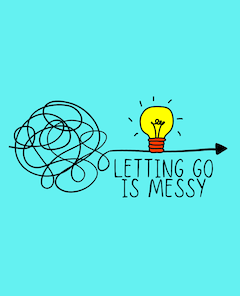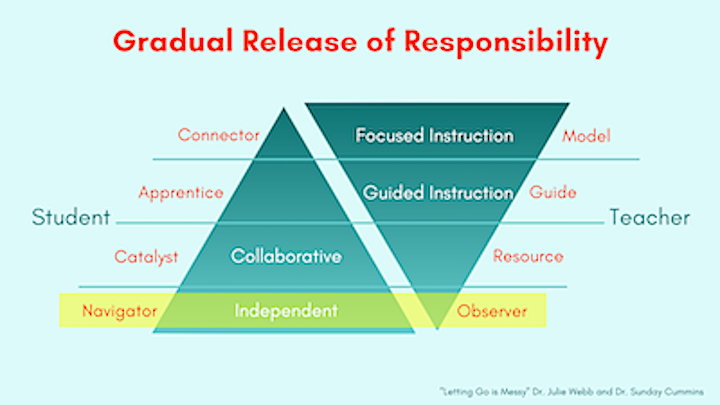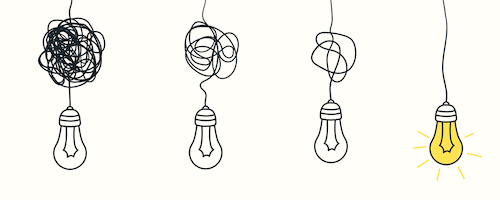GRR: When It’s Time for You Do, Help Them Fly!
A MiddleWeb Blog
 You’ve modeled making sense of a complex source.
You’ve modeled making sense of a complex source.
You’ve guided students as they practice.
You’ve acted as a resource as students collaborate.
Now it’s time for the students to navigate problem solving on their own. Easy, right?
We’re smiling. Anyone who has worked with students knows this is not always a smooth transition. The “you do” part of the gradual release is still messy. Some students fly and others fall. Why is this the case? And what can we do about it?
During reading instruction, we need to invest in the “You Do” phase of the Gradual Release of Responsibility as much as we do when we’re introducing students to something new during the “I Do” phase.
We need to set students up to be actively engaged, share clear learning expectations, and ensure that students understand the role they play. As navigators, students need to apply their knowledge of what we have been practicing in the other phases. They need to assist themselves when meaning breaks down, to know how to apply strategies and access tools on their own, and to recognize when it’s a good time to seek help.
All of these student behaviors offer unlimited opportunities for us as teachers to gain insight into our students’ thinking – which is key to identifying objectives for future lessons. What follows are a few suggestions to keep in mind as you host these learning opportunities.
Provide LOTS of “You Do” Opportunities
We cheat students when we do not provide enough time and opportunities to do the work on their own. If you are teaching in their zone of proximal development, students should struggle (in a productive way) as they begin to engage (for example) in making sense of complex sources.
This struggle is an opportunity to try out what you have taught them. Only with multiple opportunities over time (and, if needed, with continued support) will students begin to engage in the type of thinking or meaning making that we have been nurturing through the GRR.
Opportunities do not have to be isolated to “reading” lessons. They can happen across the day in multiple content areas. The trick is to be intentional in our individual and collaborative planning – looking for and setting students up for those opportunities – and then actively observing them as they do this work.
Take the Role of Active Observer
The “You Do” is an opportunity to be curious about what your students have learned. As you know, there are different ways to observe students. You might lean in while they are reading independently and confer with them. You might reflect on their written responses.
Regardless, make sure you know what you are looking for that reveals learning. Sometimes it’s helpful to break outcomes down into small steps or parts so you can more easily see what students have or have not learned. Here are some questions to help you gain clarity on what you are looking for when you observe your learners:
● What are the different steps students need to engage in to make sense of texts the way you have presented?
● What do you expect to see and hear?
● What are indicators that students may need additional support?
● What does an outcome broken down into smaller parts look like?
Let’s say you have worked with students on monitoring for meaning-making while reading informational sources. This type of strategic processing of text can be broken down into several small steps including the following:
► The students have to recognize when meaning is being made and when meaning is breaking down.
► When they notice meaning is breaking down, they have to identify which part does not make sense. Is it a vocabulary word? Is it a word they do not know how to pronounce? Is it a phrase they have never heard of? Is it a technical term related to a concept being explained? Is it the structure of the text that’s mind boggling?
► When they have identified what they are not understanding, they have to draw from a repertoire of strategies to help them make sense of the part they do not understand. (This may include a strategy you focused on in the “I do” and “We do” – see our earlier discussions.)
► Then they have to return to reading, integrating the meaning they just made into their understanding of what they are reading next.
Gather Future Teaching Objectives
When you notice what students have learned and what they still need support in doing, you will know what you need to think about for follow-up lessons. You may find that you do not need to return to “monitoring for meaning,” or whatever type of strategic processing you’ve focused on, as a whole.
Instead, you can identify the finer aspects of meaning making that need instruction. For example, you might notice that your students notice when meaning is breaking down because of an unfamiliar vocabulary word but they have a limited set of strategies for using context clues to figure out the meaning of that word.
Follow-up instruction can skip teaching for noticing unfamiliar vocabulary as well as the strategies students are already using to make sense of those words and just focus on one or two strategies that will move them forward.
And you don’t have to wait for a follow-up lesson to teach these. In the “You Do” phase the teacher is the active observer which means they can step in at opportune times to make the most of teachable moments, clarify learning for students, and get students back on track quickly.
Be careful, though. In a sense you are shifting back into the modeling (“I do”) or guiding (“We do”) part of the GRR. Totally okay but be cognizant of when you should downshift out of those roles (back into observer) to avoid depriving students of the “You Do” opportunities they need and deserve.
Document Your Observations
After teaching all day, it may be hard to remember what you observed. Brief notes that serve as a trigger for remembering what you noticed or how you supported particular students can be a lifesaver when begin to plan for follow-up instruction. Another option is to prepare in advance a short checklist of the outcomes you will be observing for (broken down into smaller parts).
Short video clips of a select group of students can also capture when students struggle as well as how they go about solving problems. This video insight can help you tailor the next lesson to your students’ specific needs. Video can also help you monitor your own behavior during “You Do,” noting when and how you step in and when you sit back and let students productively struggle – providing the opportunity to reflect on how to balance the two stances.
Treat “You Do” as a Worthy Investment
One of the many goals we have as teachers is to move students toward independence. The “You do” phase of GRR is not a final destination, though. It is a jumping off point for future teaching and learning. Students get a chance to reveal signs of mastery and indicators of readiness, and as active observers, we see more clearly the road we need to travel next.







































